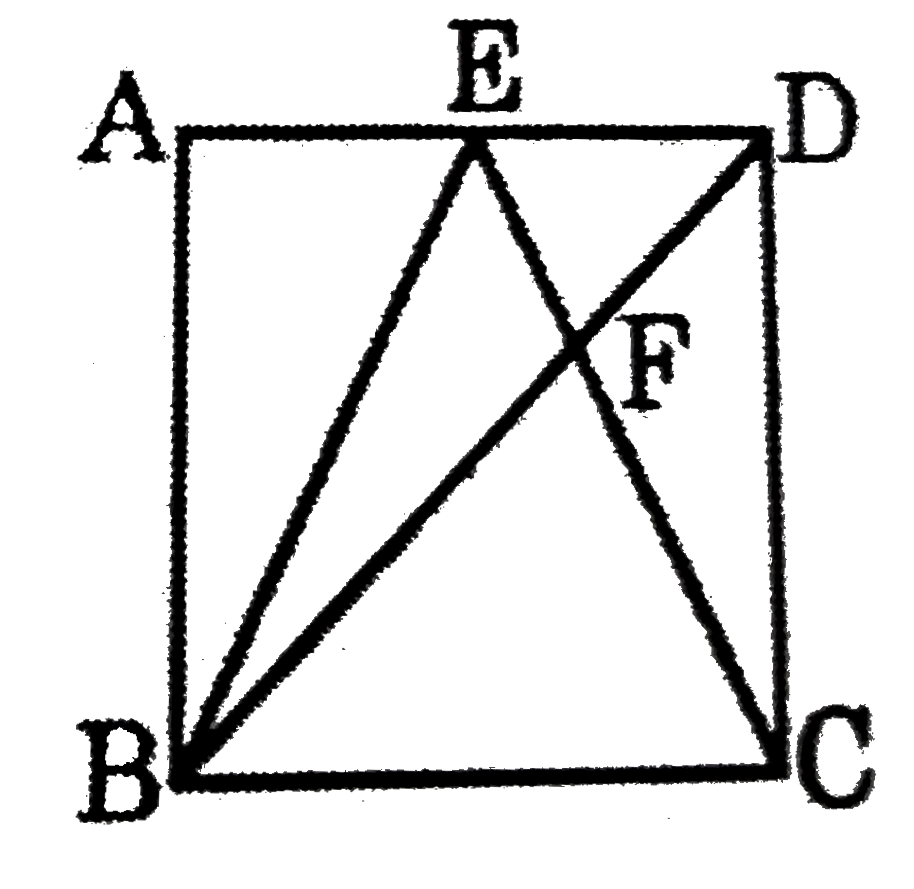In a rhombus ABCD, ∠ADC:∠BCD=1:2andEF:BD=1:3, where E and F lie on the diagonal BD, inside the rhombus, such that □AECF is a quadrlateral. Find the ratio of areas of □AECF:□ABCD.
A. 1:4
B. 2:5
c. 3:14
D. none of these
The correct Answer is:D
To solve the problem, we need to find the ratio of the areas of quadrilateral AECF to quadrilateral ABCD in the rhombus ABCD, given the conditions about angles and segments.
1. Understanding the Rhombus:
- In a rhombus, all sides are equal, and opposite angles are equal. We have angles ADC and BCD in the ratio of 1:2. Let's denote angle ADC as x and angle BCD as 2x.
2. Finding Angles:
- The sum of angles in a quadrilateral is 360∘. Therefore, we can write:
x+2x+x+2x=360∘
This simplifies to:
6x=360∘⟹x=60∘
- Thus, angle ADC = 60∘ and angle BCD = 120∘.
3. Understanding the Segment Ratios:
- We are given that EF:BD=1:3. If we let EF=k, then BD=3k.
4. Area of Rhombus ABCD:
- The area of a rhombus can be calculated using the formula:
Area=12×d1×d2
where d1 and d2 are the lengths of the diagonals. Here, we can assume d1=EF=k and d2=BD=3k.
Area of ABCD=12×k×3k=3k22
5. Area of Quadrilateral AECF:
- The area of quadrilateral AECF can also be expressed in terms of its diagonal EF and the other diagonal AC. Since EF=k and AC can be assumed to be equal to BD (as diagonals bisect each other in a rhombus), we can use the same diagonal for calculation.
- The area of AECF can be calculated as:
Area of AECF=12×EF×AC=12×k×k=k22
6. Finding the Ratio of Areas:
- Now we can find the ratio of the areas of quadrilateral AECF to quadrilateral ABCD:
Ratio=Area of AECFArea of ABCD=k223k22=13
Final Answer:
The ratio of areas of quadrilateral AECF to quadrilateral ABCD is 13.
- In a rhombus, all sides are equal, and opposite angles are equal. We have angles ADC and BCD in the ratio of 1:2. Let's denote angle ADC as x and angle BCD as 2x.
- The sum of angles in a quadrilateral is 360∘. Therefore, we can write:
x+2x+x+2x=360∘
This simplifies to:
6x=360∘⟹x=60∘
- Thus, angle ADC = 60∘ and angle BCD = 120∘.
- We are given that EF:BD=1:3. If we let EF=k, then BD=3k.
- The area of a rhombus can be calculated using the formula:
Area=12×d1×d2
where d1 and d2 are the lengths of the diagonals. Here, we can assume d1=EF=k and d2=BD=3k.
Area of ABCD=12×k×3k=3k22
- The area of quadrilateral AECF can also be expressed in terms of its diagonal EF and the other diagonal AC. Since EF=k and AC can be assumed to be equal to BD (as diagonals bisect each other in a rhombus), we can use the same diagonal for calculation.
- The area of AECF can be calculated as:
Area of AECF=12×EF×AC=12×k×k=k22
- Now we can find the ratio of the areas of quadrilateral AECF to quadrilateral ABCD:
Ratio=Area of AECFArea of ABCD=k223k22=13
The ratio of areas of quadrilateral AECF to quadrilateral ABCD is 13.
Topper's Solved these Questions
Similar Questions
Knowledge Check
In a trapezium ABCD, the diagonals AC and BD interserted other at O such that OB:OD=3:1 then the ratio of area of ΔAOB:ΔCOD is :
A3:1B1:4C9:1Dcan't be determinedThe diagonals of two squares are in the ratio of 3:2. Find the ratio of their areas.
A9:4B9:2C9:5D9:7In a rhombus ABCD the diagonals AC and BD intersect at the point (3,4) . If the point A is (1,2) the diagonal BD has the equation
Ax - y - 1 = 0Bx + y - 1 = 0Cx - y + 1 = 0Dx + y - 7 =0
The diagonals AC and BD of a rhombus intersect at (5,6). If A≡(3,2), then find the equation of diagonal BD.
View SolutionIn a trapezium ABCD, the diagonals AC and BD interserted other at O such that OB:OD=3:1 then the ratio of area of ΔAOB:ΔCOD is :
View SolutionIf the length of diagonal BD of a square ABCD is 4.8 cm, the area of the square ABCD is :
View SolutionIf the length of diagonal BD of a square ABCD is 4.8 cm, the area of the square ABCD is :
View SolutionE and F are mid-points of diagonals AC and BD of □ABCD. If G is the mid-point of seg EF, then
View Solution

